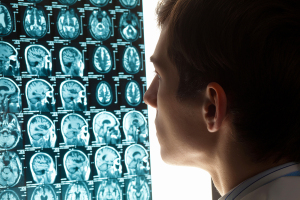Brain cancer diagnostic tests need to be done when a patient presents with a headache or an worsening pattern of migraine headache. This should be a signal that this patient needs to be referred to a neurologist.
Other signs might be hearing loss on one ear or blindness just on one eye. Other changes to look out for are memory loss, loss of speech, swallowing problems. All of this is just an alarm signal that this patient should see a neurologist.
The neurologist has the background knowledge of the brain and spine function and knows how to check the hidden reflexes that tell precisely if there is a tumor present and where it is located.
As mentioned above this can then be followed up through more specific imaging tests to confirm the location of the tumor and get the approximate size (CT scan, MRI scan, PET scan, SPECT scan).
When all of the data has been accumulated the patient will most likely be referred to a neurosurgeon, who will plan together with the neurologist the surgical therapy or other therapy.
Like in other parts of the body, it is important to get a tissue diagnosis to verify the brain cancer or to verify that it is not brain cancer. On the other hand, follow-up studies with known pathology have shown that brain cancer tends to stay inside the brain, in other words it rarely metastasizes outside the brain. The long term prognosis is more dependent on the growth pattern of the tumor than on the histology.
References
1. Cancer: Principles &Practice of Oncology. 4th edition. Edited by Vincent T. DeVita, Jr. et al. Lippincott, Philadelphia,PA, 1993. Chapter on brain cancer.
2. Cancer: Principles&Practice of Oncology. 5th edition, volume 2. Edited by Vincent T. DeVita, Jr. et al. Lippincott-Raven Publ., Philadelphia,PA, 1997. Chapter on brain cancer.
3. Conn’s Current Therapy 2004, 56th ed., Copyright © 2004 Elsevier
4. Ferri: Ferri’s Clinical Advisor: Instant Diagnosis and Treatment, 2004 ed., Copyright © 2004 Mosby, Inc







